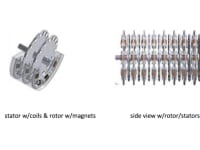
The laws of physics restrict the rotational speeds of traditional large generators due to the increased centrifugal forces. Hoover Dam generators run at around 1.5 - 2.0 Hz.; their substantial centrifugal forces require these and similar generators to run at relatively low frequencies which results in very low specific outputs (kW/lb. and kW/ft3).
DET has patented a generator that is based on Faraday's Law, NASA developed ultra-high speed flywheel technology and Formula 1 engine principles. The result is a compact, high speed generator that has the potential to operate at up to 1,000 Hz. and produce extremely high specific power outputs. Faraday's Law, that both voltage and current increase proportional to the increase in the oscillation frequency, predicts that power output increases exponentially as RPM increases linearly. Increasing the oscillation frequency by 10x increases the power output by a factor of 100 for identical generators.
The DET generator (see pictures) replaces machine mass and displacement by operating at much higher rotational speeds. F1 engines typically have >3 times the HP of an identical displacement passenger car engine because the F1 engine can operate at speeds (18,000 - 20,000 RPM) that would tear a passenger car engine apart (HP = (torque x RPM)/5250). The generator output is based on Faraday's Law; a generator operating at 10 to 500 times the frequency of typical iron-copper intense generators has the potential to be substantially smaller, lighter and less costly.
This very high output, compact and lightweight generator can be used in applications where traditional large, slow turning, heavy generators are impractical. The DET generator can be used at the base of water towers to create electrical power; DET generators installed on 20,000 typical water towers could generate a significant percentage of the entire output of Hoover Dam with zero environmental impact. Installing DET units in city water lines can create a significant amount of a city's energy needs. Because the DET units are very compact, they can potentially be placed in sensitive waterways where traditional large, bulky generators could damage the ecosystem.
In addition to the size, weight and cost advantages outlined above, the DET design has other unique advantages: 1. it creates two power pulses for each electro-mechanical interaction vs. one power pulse for traditional generators; 2. the DET generator can be engineered to run at a resonance point which greatly reduces the input energy – no other generator in the world has this capability; 3. zero torque at start up (patented feature) can allow a wind turbine blade to turn at low wind speeds; 4. variable output (patented) which matches the generator torque to the input torque to generate power at very low wind speeds, e.g., a DET unit could produce 20% of rated output at a wind speed that would cause a traditional generator to stall; and 5. the output is readily scaleable depending on the application; it uses identical rotor/stator assemblies that slide onto a common shaft.
-
Awards
-
 2017 Top 100 Entries
2017 Top 100 Entries
Like this entry?
-
About the Entrant
- Name:David Hochberg
- Type of entry:teamTeam members:David Hochberg Jon Rothenberg Amy Parker Gregory peterson Tony Komerska
- Software used for this entry:Autocad
- Patent status:patented





